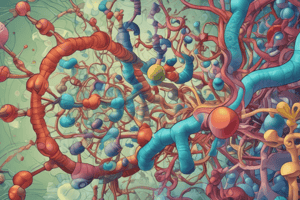Podcast
Questions and Answers
What is unique about the structure of carbon that allows it to form a wide variety of organic compounds?
What is unique about the structure of carbon that allows it to form a wide variety of organic compounds?
- It has a strong electronegativity.
- It can form four covalent bonds with other atoms. (correct)
- It can only bond with oxygen and nitrogen.
- It exists primarily as a gas under normal conditions.
Which of the following best describes monosaccharides?
Which of the following best describes monosaccharides?
- They are produced from the breakdown of fats.
- They are the simplest carbohydrates, also called simple sugars. (correct)
- They are formed from two covalently bonded simple sugars.
- They are complex carbohydrates used for structural support.
What distinguishes saturated fats from unsaturated fats?
What distinguishes saturated fats from unsaturated fats?
- Saturated fats have many hydrogen bonds and are typically solid at room temperature. (correct)
- Saturated fats are always derived from plant sources.
- Saturated fats contain fewer hydrogen atoms than unsaturated fats.
- Saturated fats are liquid at room temperature.
Which of the following is a characteristic function of phospholipids?
Which of the following is a characteristic function of phospholipids?
Which of the following statements is true regarding polysaccharides?
Which of the following statements is true regarding polysaccharides?
Which of the following best defines lipids?
Which of the following best defines lipids?
What role do carbohydrates primarily serve in living organisms?
What role do carbohydrates primarily serve in living organisms?
Which of the following statements about steroids is accurate?
Which of the following statements about steroids is accurate?
What are the building blocks of proteins?
What are the building blocks of proteins?
Which type of bond holds amino acids together in a protein?
Which type of bond holds amino acids together in a protein?
What is NOT a function of proteins?
What is NOT a function of proteins?
Which of the following is a function of hemoglobin?
Which of the following is a function of hemoglobin?
What is required for the process of dehydration synthesis?
What is required for the process of dehydration synthesis?
What distinguishes the side group of an amino acid?
What distinguishes the side group of an amino acid?
Which of the following describes a polymer?
Which of the following describes a polymer?
What is the primary role of casein in milk?
What is the primary role of casein in milk?
What is the primary function of glycogen in animals?
What is the primary function of glycogen in animals?
Which type of carbohydrate is formed by the bonding of two monosaccharides?
Which type of carbohydrate is formed by the bonding of two monosaccharides?
What differentiates saturated fats from unsaturated fats?
What differentiates saturated fats from unsaturated fats?
What are phospholipids primarily responsible for in a cell?
What are phospholipids primarily responsible for in a cell?
Which of the following best describes polysaccharides?
Which of the following best describes polysaccharides?
Which of the following proteins is primarily involved in biochemical control by speeding up chemical reactions?
Which of the following proteins is primarily involved in biochemical control by speeding up chemical reactions?
Which part of an amino acid determines its identity?
Which part of an amino acid determines its identity?
What is the process called when larger molecules are formed by the removal of water?
What is the process called when larger molecules are formed by the removal of water?
Which of the following is NOT a function of proteins?
Which of the following is NOT a function of proteins?
What type of bond connects amino acids together in a protein?
What type of bond connects amino acids together in a protein?
Flashcards
Organic Chemistry
Organic Chemistry
The study of carbon-containing compounds, many originating from living things.
Organic Compounds
Organic Compounds
Molecules containing carbon.
Carbohydrates
Carbohydrates
Organic compounds with C, H, and O in a 1:2:1 ratio; used for energy and structure.
Monosaccharides
Monosaccharides
Signup and view all the flashcards
Disaccharides
Disaccharides
Signup and view all the flashcards
Polysaccharides
Polysaccharides
Signup and view all the flashcards
Lipids
Lipids
Signup and view all the flashcards
Fatty Acids
Fatty Acids
Signup and view all the flashcards
Saturated Fatty Acids
Saturated Fatty Acids
Signup and view all the flashcards
Unsaturated Fatty Acids
Unsaturated Fatty Acids
Signup and view all the flashcards
Phospholipids
Phospholipids
Signup and view all the flashcards
Steroids
Steroids
Signup and view all the flashcards
Waxes
Waxes
Signup and view all the flashcards
Amino Acid
Amino Acid
Signup and view all the flashcards
Peptide Bond
Peptide Bond
Signup and view all the flashcards
Protein Function: Movement
Protein Function: Movement
Signup and view all the flashcards
Protein Function: Structure
Protein Function: Structure
Signup and view all the flashcards
Protein Function: Enzymes
Protein Function: Enzymes
Signup and view all the flashcards
Protein Function: Transport
Protein Function: Transport
Signup and view all the flashcards
Protein Function: Storage
Protein Function: Storage
Signup and view all the flashcards
Protein Function: Regulation
Protein Function: Regulation
Signup and view all the flashcards
Protein Function: Defense
Protein Function: Defense
Signup and view all the flashcards
Nucleic Acid
Nucleic Acid
Signup and view all the flashcards
Dehydration Synthesis
Dehydration Synthesis
Signup and view all the flashcards
Hydrolysis
Hydrolysis
Signup and view all the flashcards
Polymer
Polymer
Signup and view all the flashcards
Monomer
Monomer
Signup and view all the flashcards
Organic Chemistry
Organic Chemistry
Signup and view all the flashcards
Carbohydrates
Carbohydrates
Signup and view all the flashcards
Monosaccharides
Monosaccharides
Signup and view all the flashcards
Disaccharides
Disaccharides
Signup and view all the flashcards
Polysaccharides
Polysaccharides
Signup and view all the flashcards
Lipids
Lipids
Signup and view all the flashcards
Fatty Acids
Fatty Acids
Signup and view all the flashcards
Saturated Fatty Acids
Saturated Fatty Acids
Signup and view all the flashcards
Unsaturated Fatty Acids
Unsaturated Fatty Acids
Signup and view all the flashcards
Phospholipids
Phospholipids
Signup and view all the flashcards
Steroids
Steroids
Signup and view all the flashcards
Waxes
Waxes
Signup and view all the flashcards
Protein Building Blocks
Protein Building Blocks
Signup and view all the flashcards
Amino Acid Structure
Amino Acid Structure
Signup and view all the flashcards
Peptide Bonds
Peptide Bonds
Signup and view all the flashcards
Protein Functions - Movement
Protein Functions - Movement
Signup and view all the flashcards
Protein Functions - Structure
Protein Functions - Structure
Signup and view all the flashcards
Protein Functions - Enzymes
Protein Functions - Enzymes
Signup and view all the flashcards
Protein Functions - Transport
Protein Functions - Transport
Signup and view all the flashcards
Protein Functions - Storage
Protein Functions - Storage
Signup and view all the flashcards
Protein Functions - Regulation
Protein Functions - Regulation
Signup and view all the flashcards
Protein Functions - Defense
Protein Functions - Defense
Signup and view all the flashcards
Nucleic Acids
Nucleic Acids
Signup and view all the flashcards
Dehydration Synthesis
Dehydration Synthesis
Signup and view all the flashcards
Hydrolysis
Hydrolysis
Signup and view all the flashcards
Polymer
Polymer
Signup and view all the flashcards
Monomer
Monomer
Signup and view all the flashcards
Study Notes
Organic Chemistry
- Organic chemistry studies organic compounds, which contain carbon.
- Many organic compounds come from living things.
- Most naturally occurring compounds are organic.
Carbohydrates (A)
- Carbohydrates are composed of carbon, hydrogen, and oxygen in a 1:2:1 ratio.
- Sugars and starches are carbohydrates.
- Living things use carbohydrates for energy and structural support.
Monosaccharides
- Simplest carbohydrates, also called simple sugars.
- Examples include glucose and fructose.
Disaccharides
- Two monosaccharides bonded together.
- Examples include sucrose (glucose + fructose), lactose (glucose + galactose), and maltose (glucose + glucose).
Polysaccharides
- Large polymers of linked monosaccharides.
- Examples include starch, found in wheat, rice, corn, and potatoes, which plants use to store glucose and animals to store glucose as glycogen.
- Cellulose is a structural polysaccharide found in plants.
- chitin
Lipids (B)
- Lipids include fats, oils, waxes, and steroids.
- Lipids are generally composed of carbon, hydrogen, and oxygen, similar to carbohydrates, but in different ratios.
Fats
- Composed of glycerol and three fatty acids.
- Used for energy storage and insulation.
- Excess carbohydrates are converted to fats.
- Fatty acid structure determines fat characteristics.
- Animals typically contain about 30 fatty acids.
Proteins (C)
- Proteins are organic compounds containing carbon, hydrogen, oxygen, nitrogen, and sometimes sulfur.
- Essential to all living things (e.g., muscles, hair, skin).
Amino Acids
- Building blocks of proteins.
- About 20 different amino acids are used in protein synthesis across species.
- Amino acids contain an amino group (-NH2), a carboxyl group (-COOH), and a side group (determines amino acid identity).
- Amino acids are bonded together by peptide bonds.
Protein Functions
- Proteins have diverse functions including movement (actin and myosin in muscle fibers), structure (collagen), biochemical control (enzymes), transport (hemoglobin), storage (casein in milk), and regulation (hormones).
Nucleic Acids (D)
- Large, complex molecules composed of carbon, hydrogen, oxygen, nitrogen, and phosphorus.
- These are considered the genetic material of the cell.
- Examples of nucleic acids include DNA and RNA.
Studying That Suits You
Use AI to generate personalized quizzes and flashcards to suit your learning preferences.




